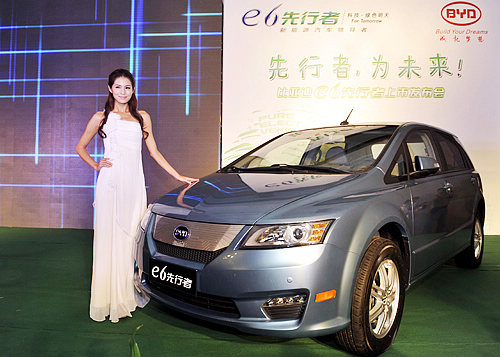|
 |
|
BIG DEBUT: BYD's all-electric crossover e6 on display in Shenzhen on October 26, 2011 (CHEN YEHUA) |
A single, national standard will unify the various standards of different EV manufacturers, creating an open and fair space for competition.
China hopes to have more than 500,000 electric cars on the road by 2015 and 5 million by 2020.
The government will help create one to three automakers that can each produce more than 1 million new energy cars per year by 2020. It will also help establish three to five automakers which can each produce more than 500,000 new energy cars per year by 2020.
The target is ambitious, especially since China currently has only approximately 10,000 EVs on the road. To hit the goal, the average growth rate in EV production and sales volume will have to be as high as 118.67 percent until 2015 and then 58.48 percent in the second half of this decade.
Governments at various levels have implemented various measures to support the EV industry by offering generous subsidies for EV purchases and R&D.
In August 2010, the State Assets Supervision and Administration Commission set up the Electric Vehicle Alliance, with participation from 16 centrally administered state-owned enterprises. It is regarded as a national team for upgrading the overall technical level of China's EV industry. Enterprises in the alliance cover EV makers including FAW, Dongfeng and Changan, battery makers, energy providers such as the State Grid and China Southern Power Grid, and other auto part makers.
The alliance will mainly work to form a complete industrial chain and integrate the efforts in developing China's EV industry.
The national plan and technical standard to be released will be the major tools to accelerate the large-scale industrialization and commercialization of China's EV industry. The owners with the winning standards will be the biggest beneficiary and take a dominant market share, said Li.
China already has made progress in the EV industry.
Take battery and car maker BYD Automobile Co. Ltd. for example. BYD has formed a complete industrial chain covering R&D to affiliated EV parts, according to Lian Yubo, Vice President of BYD.
On October 26, BYD launched its electric model car, the e6, which can run about 300 km on a single charge, giving it the longest range of any EV in the Chinese market. Before e6, BYD launched a dual-mode hybrid, the BYD F3DM, on the market in 2008.
In addition to BYD, more than 30 domestic EV makers have introduced their own models, some of which include buses that run on electricity. Local governments are usually major buyers of electric buses. As early as 2003, seven cities including Beijing, Tianjin, Wuhan of Hubei Province, Hangzhou of Zhejiang Province and Shenzhen of Guangdong Province launched assessments on the operation of new energy vehicles in their own cities.
During the 2008 Beijing Olympic Games, a fleet of 595 new energy buses traveled a total of 3.7 million km and carried more than 4.4 million passengers, representing the biggest new energy vehicle fleet in the history of the Olympics.
Domestic car manufactures, including FAW, Dongfeng, SAIC, Changan, Chery and BYD, all have EV development plans.
The data from the MIIT showed that the industrialization of EV parts has seen a big boost. Battery producers, such as BYD, Tianjin Lishen Battery Joint Stock Co. Ltd., Shenzhen Bak Battery Co. Ltd., and Wangxiang Group have invested heavily in accelerating industrialization of EV batteries.
In addition, more auto parts makers have made efforts to complete the EV industrial chain. It is estimated that China will be able to provide auto parts for 1 million EVs per year in the next two to three years.
| 